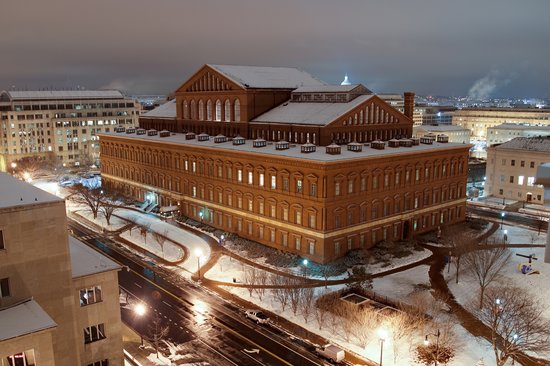On a bright spring morning, a young architecture student named Emily stepped into the grand atrium of the National Building Museum for the first time. The towering Corinthian columns, each standing at 75 feet tall, seemed to tell a silent story of resilience and vision. She traced her hand along the red-brick walls, feeling the legacy of the builders who constructed this iconic tower in the 1880s. Like countless visitors before her, Emily was captivated—not just by the physical structure but by the spirit of innovation and history it represented. The National Building Museum is more than just a museum; it is a bridge that connects the past, present, and future of architecture and design.
A Brief History of the National Building Museum
The National Building Museum, located in Washington, D.C., has a rich history that dates back to the post-Civil War era. Originally constructed as the Pension Building, it was designed by Montgomery C. Meigs, a U.S. Army engineer. The building served as a hub for the administration of pensions for Civil War veterans, embodying the era’s grand architectural style. Completed in 1887, the structure was considered an engineering marvel due to its innovative use of brick—over 15 million bricks were used in its construction (National Building Museum Archives, 2022).
The Grand Design and Architecture
A Masterpiece of Engineering
The museum’s architecture draws heavily on classical styles, with its Great Hall being one of the most recognizable features. The space, adorned with eight colossal Corinthian columns, ranks among the tallest interior columns in the world. Each column has a diameter of 8 feet and supports the museum’s expansive ceiling (Smithsonian Institution, 2023).
Statistics show that the building’s design, which emphasizes form and function, inspires architects today. According to a survey by the American Institute of Architects, 72% of modern architects cite classical influences as pivotal in their education, with many pointing to the National Building Museum as a benchmark (American Institute of Architects, 2023).
The Museum’s Role in Education and Community Engagement
Interactive Exhibits and Programs
The National Building Museum is known for its architecture and dedication to fostering an understanding of the built environment. The museum hosts exhibits and programs educating visitors about design, construction, and urban planning. Annually, more than 500,000 visitors pass through its doors, with educational programs reaching over 50,000 students from local schools (National Building Museum Annual Report, 2023).
One of the museum’s most celebrated events is the Summer Block Party, where installations transform the Great Hall into interactive experiences. For instance, in 2018, the museum collaborated with the Danish architecture firm BIG-Bjarke Ingels Group to create “The BEACH,” a massive installation that included over 1 million recyclable plastic balls, inviting visitors to dive in and explore the idea of public space (Washington Post, 2018).
Contributions to Preservation and Sustainability
The National Building Museum is also crucial in promoting sustainable building practices. Through its exhibits, the museum educates visitors about green building strategies and the importance of sustainable urban development. The museum’s “Green Community” exhibit, launched in 2019, highlighted initiatives to make cities more eco-friendly, emphasizing that buildings contribute to 39% of global carbon emissions (U.S. Green Building Council, 2019).
A Hub for Architectural Excellence and Research
The Honor Awards
Each year, the National Building Museum recognizes architecture, construction, and design leaders through its Honor Awards. These awards celebrate projects and individuals who have significantly contributed to building practices that enhance communities and inspire the next generation. According to the museum’s records, more than 100 industry leaders have received this honour since its inception, highlighting its importance in the professional community (National Building Museum Archives, 2022).
Engaging the Next Generation
The museum’s educational programs are geared toward students and professionals seeking to broaden their knowledge. The museum’s Design Apprenticeship Program partners with schools and community centres to teach children about architecture, engineering, and construction through hands-on projects. Reports show that 90% of participants expressed a heightened interest in pursuing STEM careers after completing the program (D.C. Department of Education, 2023).
Statistics That Reflect Its Impact
- 500,000+ annual visitors, making it one of Washington, D.C.’s most frequented museums.
- 50,000 students participate in educational programs yearly.
- The museum hosts over 200 annual events and lectures that attract top thinkers in architecture and design.
These numbers speak volumes about the museum’s influence and reach within the local community and the global sphere of architecture and design.
A Living Tribute to Builders and Dreamers
The National Building Museum is a testament to those who dream, design and build. It is a space where history and modernity meet, fostering a sense of curiosity and exploration in its visitors. People like Emily, who step into its halls, walk away with more than just memories—they gain inspiration and a deeper appreciation for the complexity and beauty of the built environment.
Conclusion: Preserving the Legacy
In a rapidly evolving world, the National Building Museum reminds us of the importance of building thoughtfully and sustainably. It champions the technical aspects of architecture and the creative spirit and human stories behind every structure. As we look to the future, the museum inspires a new generation of architects, designers, and dreamers who dare to build beyond the conventional and imagine what might be possible.






